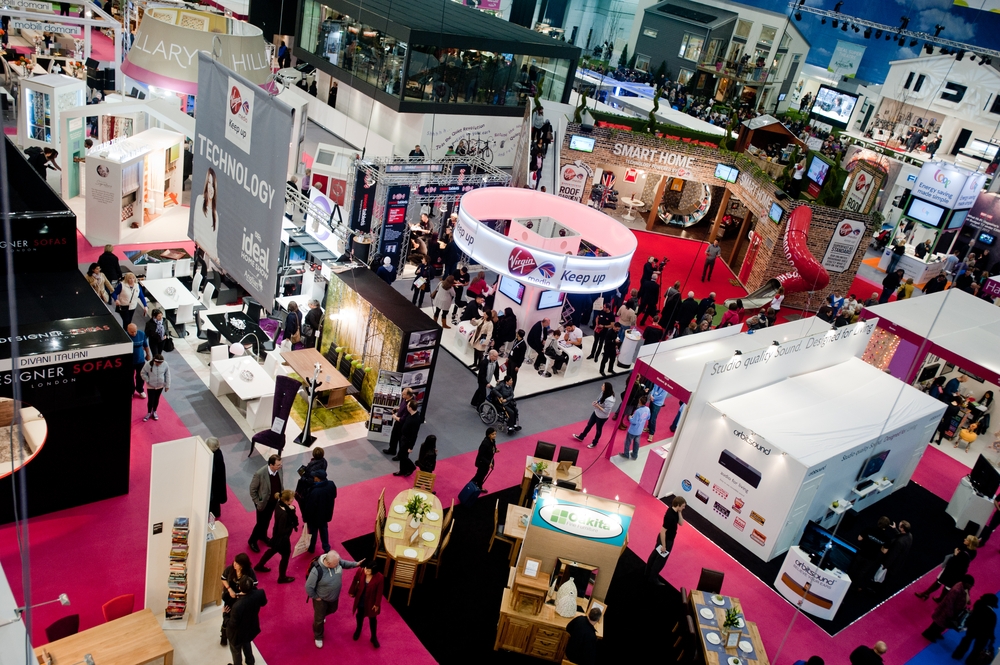Understanding What Is a Trade Show and How It Can Benefit Your Business
By Morten Numrich · 8. February 2024
Ever wondered what is a trade show?
Simply put, it’s a specialized event where companies converge to present and discover the latest industry offerings.
Meant for networking and business growth, these events cater to professionals💼 seeking market insights, collaborations, and opportunities.
In this guide, we’ll unfold what you need to know about trade shows, from their fundamental purpose to the impact they can have on your business ventures.
Key Takeaways
- Trade shows are B2B wonderlands, pulling in a hefty $10.2 billion in 2022, and they act as premier stages for businesses to flaunt their wares, schmooze with peers, and ink some sweet deals.
- Putting on a show costs a pretty penny with booth prices sometimes soaring over $300/sq ft. But savvy small biz bosses can still slice that bill with some early bird planning and ROI daydreaming.
- Post-show ghosting is a big no-no. Capture those leads like a pro and unleash the power of follow-up finesse to turn handshakes and business cards into cha-ching!
Defining Trade Shows: A Comprehensive Overview
 trade show
trade show
Trade shows serve as vibrant platforms, showcasing the latest products and services, and creating an environment conducive to networking, competition and collaboration among industry professionals.
In 2022 alone, trade shows played a critical role for B2B companies, reaching a staggering market size of $10.2 billion.
This underscores their economic importance and the role they play in various industries.
Trade shows can adapt to various scales of events and geographical locations, whether they’re held in massive convention centers or carried out virtually.
From tech startups unveiling their latest innovations to established brands launching new product lines, trade shows provide a platform for companies to showcase their offerings to a targeted audience.
Trade Fairs vs. Trade Shows
You might be wondering, are trade fairs and trade shows identical?
Well, not quite. While both are platforms for businesses to display their products and interact with potential buyers, there are subtle differences between the two.
Trade fairs, such as the Frankfurt Book Fair, are open to the public and may cater to multiple industries. Think of your local car or food fair.
These events often include elements of public engagement and entertainment, and can even encompass cultural or educational activities.
On the other hand, most trade shows are primarily sales-driven events, focusing on business-to-business (B2B) relationships within a specific industry. They are more about:
- Forging business deals
- Collaborations
- Showcasing new products and services
- Networking with industry professionals
Trade shows are not typically focused on entertaining the general public.
Depending on where you are in the world, you may hear one term used more than the other.
In Europe, you’ll likely hear ‘trade fair,’ while ‘trade show’ is more common in the United States.
Major Venues for Trade Shows
You might be curious about the locations where these trade shows are held. From the ExCeL London with its large scale exhibition, and modern facilities to the globally recognized Dubai World Trade Centre, and even the famous Las Vegas Convention Center, trade shows are held at major venues around the world.
Each venue offers a unique blend of ambiance, functionality, and accessibility.
For instance, Olympia London provides a historic atmosphere with modern functionality, while Manchester Central stands out with its significant venue in central Manchester.
These venues provide the perfect backdrop for businesses to showcase their offerings and engage with potential clients.
The Anatomy of a Trade Show
 tradee show booth
tradee show booth
Let’s delve into the core elements of a trade show.
With a myriad of exhibitors each tailoring their booths to reflect their specific goals and attendees ranging from potential buyers to industry analysts, a trade show is nothing short of a vibrant business ecosystem.
The design of the booths plays a critical role in attracting attendees. From interactive product demonstrations to networking spaces, a unique and attractive booth design can help reinforce the brand’s image.
Coupled with techniques such as promotional items such as product demos and interactive media, these booths become the focal point of a trade show, drawing the attention of attendees and fostering potential business collaborations.
Exhibitors and Their Goals
Exhibitors constitute the lifeline of a trade show. They come with a variety of primary goals, including brand awareness, lead generation, and networking.
Trade shows often serve as a platform for businesses to launch new products and introduce them to the market.
With a significant proportion of attendees having buying authority, trade shows are crucial for generating sales leads and closing deals.
Beyond sales, they present a unique opportunity for businesses to strengthen their marketing funnel and their brand presence within an industry, expand into new markets, and improve customer relationships.
After all, what better way to get direct feedback and foster customer loyalty than engaging with them face-to-face?
Booth Design and Marketing Materials
An exhibitor booth’s design influences its attractiveness to attendees significantly. Everything from the layout and color schemes to the flooring and in-booth media needs to align with the brand’s identity.
But it’s not just about looking good. Practicality is key. The booth should have:
- Sufficient space for interaction
- Product demonstrations
- Staff mobility
- Ability to accommodate private discussions when necessary
And let’s not forget about the marketing materials. These need to convey the exhibitor’s key brand message and product benefits in a clear and memorable way to attendees.
In this digital age, incorporating interactive technology, touchscreens, and digital signage into promotional materials can enhance attendee engagement.
Why Attend a Trade Show?
 trade show event
trade show event
Having outlined what a trade show entails, we now turn our attention to the reasons for attending one.
From direct sales opportunities to networking, trade shows offer a plethora of benefits for both businesses and industry professionals.
Trade shows provide businesses with a unique platform to scale up🔝 and develop industry relationships.
It enhances their visibility and credibility within the industry. For industry professionals, they offer networking opportunities, a chance to meet potential buyers, and a platform to stay informed about the latest industry trends.
So whether it’s about generating sales, building brand awareness, or just getting a pulse of the industry, trade shows have something for everyone.
For Businesses
Trade shows offer businesses an exclusive chance to connect with new target audience and demographics, which might be challenging to reach via other marketing avenues.
They also provide a platform for launching new products effectively with hands-on demonstrations.
Moreover, exhibiting at a trade show offers several benefits, including:
- Boosting brand awareness
- Creating relationships with the press, leading to media coverage for future events
- Connecting with clients face-to-face, building rapport and trust for more confident transactions
So, whether it’s about attracting new customers or strengthening relationships with existing ones, trade shows offer an unmatched platform for businesses to reach their marketing and sales goals.
For Industry Professionals
Trade shows act as excellent networking platforms for industry professionals and industry members, enabling them to meet potential customers and suppliers, and also assess competitors.
In addition to networking, attending trade shows offers several benefits:
- Meeting potential buyers and forging long-lasting business partnerships
- Providing an educational platform to gain a deeper understanding of the industry
- Enhancing knowledge and appreciating the broader picture of the market’s ecosystem
So whether it’s about closing a deal or just staying informed about the latest industry trends, trade shows offer a wealth of opportunities for industry professionals.
The Costs Associated with Trade Show Participation
 cost analysis
cost analysis
Despite the numerous benefits of participating in trade shows, it’s crucial to acknowledge the accompanying costs. These range from:
- booth space and display creation
- shipping
- staffing
- at-show services
- attendance fee
- travel
- accommodation
The cost of a trade show booth can vary widely, with the price per square foot often exceeding $300 for smaller booths and ranging between $200-300 for larger exhibits.
Incorporating high-tech features like a video wall can significantly increase the cost, sometimes tripling the initial estimates. Additional costs such as:
- shipping
- material handling
- staffing
- at-event utilities
also contribute to the overall cost of trade show participation.
Budgeting Tips for Smaller Companies
For smaller companies, the cost💰 of participating in a trade show can be daunting. However, there are ways to manage these costs effectively.
One way is to plan and budget in advance. This includes considering the size and location of the booth, the cost of shipping and handling materials, and staffing needs.
It’s also important to consider the potential return on investment. For example, if a company is launching a new product, the potential sales generated from the trade show could outweigh the costs of participation.
Preparing for Your Next Trade Show: Strategies for Success
 strategy session
strategy session
Bearing the trade show’s costs and potential benefits in mind, let’s explore strategies for successful preparation. This begins with:
- Setting clear goals for brand awareness, lead generation, and relationship building
- Starting team arrangements early
- Creating a logistics document
- Setting achievable goals for the event
- Developing a pre-show marketing campaign
- Aligning marketing efforts across various platforms, including email and pre-event activities
In today’s digital age, social media plays a crucial role in trade show preparation. Here are some creative ways to utilize social media for trade show promotion:
- Invite attendees to your booth for activities or demonstrations on social media platforms
- Promote event-specific giveaways to create a buzz around your participation
- Utilize event-specific hashtags on social media to increase visibility and engagement before, during, and after the trade show
By implementing these strategies to generate business, companies can boost engagement and create a buzz around their participation physical presence in trade shows.
The Sales Team’s Role
The success🚀 of an exhibit at a trade show hinges significantly on the sales team’s performance.
Effective training tailored to the unique dynamics of a trade show is crucial for preparing the sales team, enhancing visitor engagement, and lead retrieval.
Sales team members, also known as company representatives, must be well-equipped with marketing collateral, demonstrate a comprehensive understanding of the company’s value proposition, and the ability to handle common questions and objections.
Properly trained sales teams employing interpersonal skills and role-playing exercises are more adept at managing leads on the trade show floor and closing deals with prospects.
Post-Event Follow-Up
Even though the main activities take place during the trade show, post-show actions are equally crucial.
Following up with leads immediately after the trade show is crucial for capitalizing on the connections made during the event.
Implementing a structured timeline ensures that potential leads are not overlooked, and personalizing follow-up emails can enhance the effectiveness of the communication.
Efficient lead capture at trade shows often employs applications that integrate with a CRM system, allowing for better organization and prioritization based on potential for conversion.
To generate leads effectively, understanding the B2B sales cycle, which can last from months to years, necessitates a patient follow-up approach, supported by the use of automated yet personalized email systems to maintain consistent communication.
Notable Trade Show Examples
Examining some renowned examples is an excellent way to comprehend the significance and impact of trade shows.
From the Consumer Electronics Show (CES) in Las Vegas, one of the largest trade shows globally, to the Hannover Messe in Germany, a flagship industrial trade show, these events attract a vast number of attendees and provide a platform for businesses to showcase their offerings.
Other examples include the High Point Market in North Carolina, the principal furniture trade show on a worldwide scale, and the International Furniture Fair, which is also a major hub in the hospitality sector, like the National Restaurant Association Show in Chicago.
Summary
In conclusion, trade shows offer a unique platform for businesses to showcase their products, connect with potential clients, and stay abreast of industry trends.
Whether you’re a small business looking to make your mark, a large corporation launching a new product, or an industry professional keen on networking and staying updated on industry trends, trade shows offer a wealth of opportunities.
So, when planning your next marketing strategy, remember to consider the power of trade shows as they can truly catapult your business to new heights.
Frequently Asked Questions
What is the purpose of trade shows?
Trade shows are a great way to stay ahead of the game by learning about new developments in your industry and keeping an eye on your competitors. It’s all about staying sharp and making connections.
What is a trade show simple definition?
A trade show, also known as a trade fair, is an industry-specific event where businesses showcase products, promote services, and build relationships with distribution channels.
It’s a great opportunity to network and stay updated on market trends.
What is the difference between trade shows and trade fairs?
Trade shows are all about business, while trade fairs are more of a public affair, with entertainment and engagement for all. So, one is a business party, and the other is a fun fair.
What are the benefits of attending a trade show?
Attending a trade show can provide direct sales opportunities, networking, industry insights, media opportunities and a platform for expanding your business relationships. It’s a great way to boost your business!
What are the costs associated with trade show participation?
Trade shows can be quite the investment, including booth space, display creation, shipping, staffing, at-show services, attendance fee money, and travel and accommodation expenses. It all adds up!

